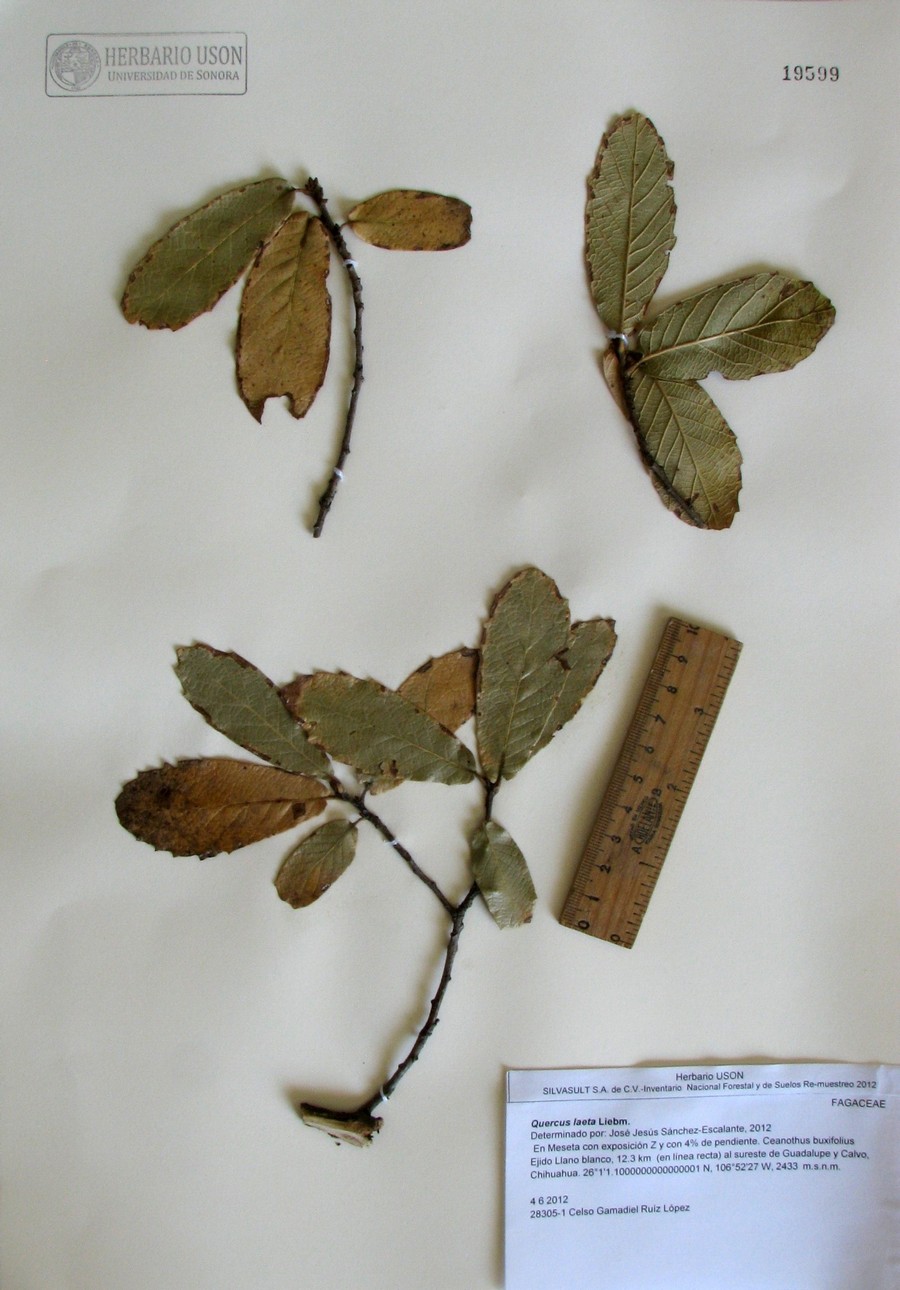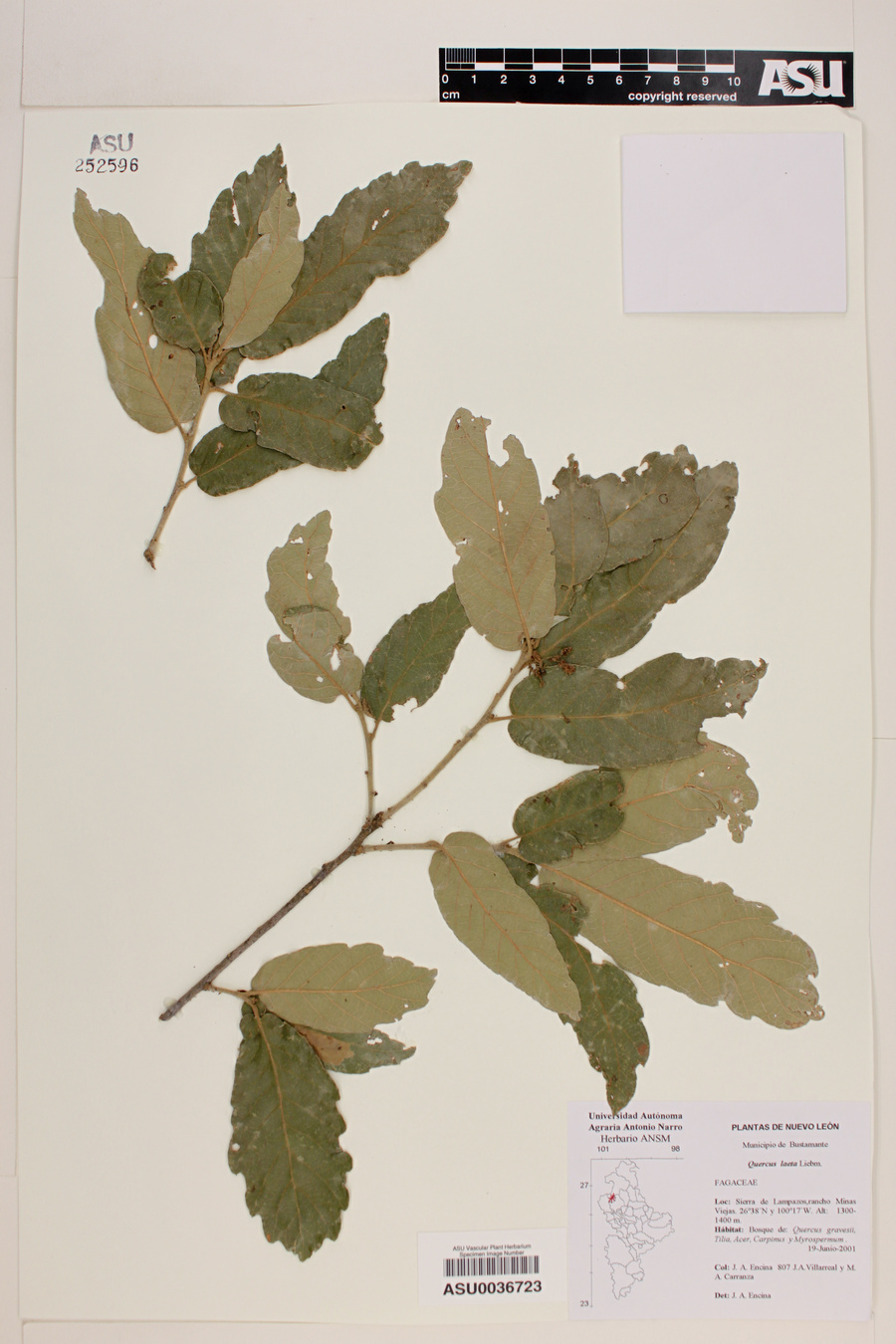| Quercus laeta | |
| Author |
Liebm. 1854 Overs. Kongel. Danske Vidensk. Selsk. Forh. Medlemmers Arbeider 1854: 179 Diagnosis here |
| Synonyms | centralis Trel. 1924 Diagnosis here clivicola Trel. & C.H.Muller 1936 (A. Camus : 206) laeta f. heterophylla Trel. 1924 obscura Trel. 1924, nom. illeg., not Seem. 1897 pallescens Trel. 1924 Diagnosis here pandurata var. laeta (Liebm.) Wenz. 1884 prinopsis Trel.1924 (A. Camus : 230) Diagnosis here transmontana Trel. 1924 (A. Camus = n° 252) |
| Local names | encino
algodoncillo; |
| Range | Mexico (Aguascalientes,
Coahuila, DF, Durango, Guanajuato, Hidalgo, Jalisco, Mexico, Michoacan,
Nayarit, Nuevo Leon, Sinaloa, San Luis Potosi, Zacatecas); 2300 - 2700
m; |
| Growth habit | 5 - 10 m tall;
sometimes shrub to 60 cm high; crown broad; branches twisted, spreading;
|
| Leaves | 5-14 x 2-7 cm;
deciduous; thick, leathery, stiff; oblanceolate, oblong-lanceolate or
oboval, seldom elliptic; apex round or acute, mucronate; base cordate
or subcordate, sometimes cuneate; margin thick, slightly revolute, undulate,
entire or most often with 3-6 pairs of teeth on the apical 2/3, with curved
mucros; young leaves grey-green adaxially with abundant stellate trichomes,
abaxially densely stellate pubescent; mature leaves dark lustrous olive
green above, rough, nearly glabrous or with 9 rayed sellate trichomes
on the whole surface and simple uniseriate glandular trichomes along midrib,
especially the base; pale glaucous beneath, glabrescent, with an even
indumentum made of long, shortly pediculate, 9-rayed spreading stellate
hairs, without masses of glandular secretions but with few glandular trichomes,
mostly on veins; 7-12 vein pairs impressed above, prominent beneath, ending
in the mucro of the teeth, the basal veins forked before reaching the
margin; epidermis white-papillose ; petiole pubescent 2-10 mm long; |
| Flowers | flowering in May; male catkins 4-6 cm long, with numerous flowers; female ones 1-3 cm long, with 1 to 3 pubescent flowers; |
| Fruits | acorn ovoid,
0.6-1.3 cm long, 0.6-0.7 cm in diameter; singly or to 3 sessile or on
a short peduncle less than 5 cm long; apex obtuse, mucronate; enclosed
1/3 or 1/2 by cup; cup 0.8-1.1 cm in diameter, with pubescent scales narrowed
at apex and thickened at base; maturing in 1 year, from September to November; |
|
Bark, twigs and |
dark greyish bark; twigs 1.5-3.5 mm thick, tawny, floccose-glabrescent (fascidulate trichomes and long simple ones), grooved, with few pale yellow lenticels; bud globose or ovoid, obtuse, 2-4 mm long, 1.5-2.5 wide; stipules hairy, deciduous except near apical buds, 4-6 mm long; |
| Hardiness zone, habitat | hardy;
prefers dry, rocky soils; |
| Miscellaneous |
-- A. Camus : n° 232
; -- Possible confusion with
other similar oaks : see all differences HERE. |
| Subspecies and varieties |
|
| Pictures |
More pictures HERE
|







.jpg)


